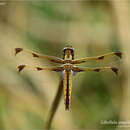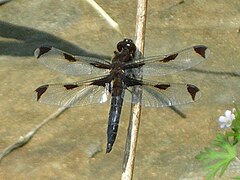tr
kırıntılardaki isimler


Libellula angelina és una espècie de libèl·lula pertanyent a la família Libellulidae.
Viu als llacs i aiguamolls d'aigua dolça.[3]
Es troba al centre i el nord de la Xina, el Japó (Honshu, Shikoku, Kyushu, etc.), Corea del Nord i Corea del Sud.[2]
Es troba amenaçada d'extinció per la destrucció i degradació del seu hàbitat natural (especialment, l'expansió urbana), la desaparició dels herbassars (els quals són emprats com a refugi per les femelles i els mascles immadurs) i la introducció d'espècies exòtiques (com ara, el cranc de riu americà -Procambarus clarkii-, la perca americana -Micropterus salmoides- i el coipú -Myocastor coypus-)[4] que la depreden directament o es nodreixen de les plantes aquàtiques que li són vitals per a subsistir. En el cas específic del Japó, se la considera un tresor natural i gaudeix de la protecció del Ministeri de Medi Ambient d'ençà de l'any 1993, la qual cosa comporta que la seua captura està prohibida per llei però no així la salvaguarda del seu hàbitat.[2]
Libellula angelina és una espècie de libèl·lula pertanyent a la família Libellulidae.
Libellula angelina, also known as bekko tombo, is a species of dragonfly in the family Libellulidae, native to China and Japan. It is under threat by rapid loss of the ponds and other small water bodies it uses as habitat, and is currently classified as critically endangered by the IUCN.
The bekko tombo is a golden to rusty-brown dragonfly, with a dark stripe down the centre of the abdomen and a distinctive pattern of dark markings on its wings. Like other members of the family Libellulidae, this dragonfly has a relatively short, broad abdomen, and its body is distinctly shorter than its wingspan.[2]
The bekko tombo occurs in central and northern China, Japan (Honshu, Shikoku, Kyushu and offshore islands) and Korea.[1] It inhabits old and stable ponds with moderate plant growth in lowland hill areas. It requires clear, open water in which the nymphs crawl around in the bottom sediments.[1][2]
The bekko tombo is univoltine. It has a larval period of one year. Eggs hatch from May to June, and adults emerge the following spring. There is often fierce competition between males for access to reproductive females. Females typically begin to lay eggs in water immediately after copulation, often guarded by their mate. However, females of some species can store live sperm in their body for a number of days.[2]
The bekko tombo has experienced drastic declines in recent decades, mostly driven by the continuing disappearance of its required breeding habitats, old and stable ponds with vegetated borders. Introduced predators such as the largemouth bass (Micropterus salmoides) have also had an impact. The species has been protected in Japan since 1993, and efforts by various NGOs are ongoing to preserve and reconstitute suitable breeding habitats.[2] Current population is estimated at less than 5,000 individuals, and the species has been classified as critically endangered by the IUCN.[1]
Libellula angelina, also known as bekko tombo, is a species of dragonfly in the family Libellulidae, native to China and Japan. It is under threat by rapid loss of the ponds and other small water bodies it uses as habitat, and is currently classified as critically endangered by the IUCN.
Libellula angelina Selys, 1883 è un insetto della famiglia Libellulidae, con areale asiatico.
La libellula angelina è molto più piccola rispetto alle altre libellule e al fusto è tutta nera con parti marrone scuro, ha delle ali con tre macchie sul margine di colore palissandro-rossastro.
È diffusa in Cina, Giappone, Corea del Nord e Corea del Sud.
I suoi habitat naturali sono i laghi d'acqua dolce e paludi d'acqua dolce.
Libellula angelina Selys, 1883 è un insetto della famiglia Libellulidae, con areale asiatico.
Libellula angelina is een libellensoort uit de familie van de korenbouten (Libellulidae), onderorde echte libellen (Anisoptera).[2]
De soort staat op de Rode Lijst van de IUCN als kritiek, beoordelingsjaar 2006, de trend van de populatie is volgens de IUCN dalend.[1]
De wetenschappelijke naam Libellula angelina is voor het eerst geldig gepubliceerd in 1883 door Selys.
Bronnen, noten en/of referentiesLibellula angelina – gatunek ważki z rodzaju Libellula należącego do rodziny ważkowatych.
Libellula angelina – gatunek ważki z rodzaju Libellula należącego do rodziny ważkowatych.
Libellula angelina é uma espécie de libelinha da família Libellulidae.
Pode ser encontrada nos seguintes países: China, Japão, Coreia do Norte e Coreia do Sul.[1]
Os seus habitats naturais são: lagos de água doce intermitentes e marismas intermitentes de água doce.[1]
Está ameaçada por perda de habitat.[1]
Libellula angelina é uma espécie de libelinha da família Libellulidae.
Pode ser encontrada nos seguintes países: China, Japão, Coreia do Norte e Coreia do Sul.
Os seus habitats naturais são: lagos de água doce intermitentes e marismas intermitentes de água doce.
Está ameaçada por perda de habitat.
Libellula angelina là một loài chuồn chuồn ngô thuộc họ Libellulidae. Loài này có ở Trung Quốc, Nhật Bản, Bắc Hàn, và Hàn Quốc. Các môi trường sống tự nhiên của chúng là hồ nước ngọt có nước theo mùa và đầm nước ngọt có nước theo mùa. Nó bị đe dọa do mất môi trường sống.
Phương tiện liên quan tới Libellula angelina tại Wikimedia Commons
Libellula angelina là một loài chuồn chuồn ngô thuộc họ Libellulidae. Loài này có ở Trung Quốc, Nhật Bản, Bắc Hàn, và Hàn Quốc. Các môi trường sống tự nhiên của chúng là hồ nước ngọt có nước theo mùa và đầm nước ngọt có nước theo mùa. Nó bị đe dọa do mất môi trường sống.
Libellula angelina Selys, 1883
СинонимыLibellula angelina (лат.) — вид разнокрылых стрекоз из семейства настоящих стрекоз. Распространён в Азии — центральном и северном Китае, в Японии (Хонсю, Сикоку, Кюсю и на некоторых близрасположенных островах) и на Корейском полуострове[2]. Представители обитают близ старых и стабильных прудов с умеренно высокой молодой растительностью на низменных скальных местностях[2]. Местности с открытыми водоёмами также важны[2].
Libellula angelina (лат.) — вид разнокрылых стрекоз из семейства настоящих стрекоз. Распространён в Азии — центральном и северном Китае, в Японии (Хонсю, Сикоку, Кюсю и на некоторых близрасположенных островах) и на Корейском полуострове. Представители обитают близ старых и стабильных прудов с умеренно высокой молодой растительностью на низменных скальных местностях. Местности с открытыми водоёмами также важны.
Самка
Самка
玳瑁斑蜻蜓(學名:Libellula angelina,日語:鼈甲蜻蛉)是蜻屬下的一種蜻蜓。發現於中國、日本宮城縣以南的本州、四国、九州地區和朝鮮半島,而在韓國可能已經滅絕。
雄性成蟲體長37~45毫米(1.5~1.8英寸),腹長25~31毫米(0.98~1.22英寸),雌性較小腹24~28毫米(0.94~1.10英寸)。因為翅膀的斑紋類似龜甲,所以在日本又被叫做“鼈甲蜻蛉”。雄性成蟲通體黑色,雌性腹部有黑色條紋,體色基本為黃褐色。

 分類 界 : 動物界 Animalia 門 : 節足動物門 Arthropoda 綱 : 昆虫綱 Insecta 目 : トンボ目 Odonata 科 : トンボ科 Libellulidae 亜科 : ヨツボシトンボ亜科 Libellulinae 属 : ヨツボシトンボ属 Libellula 種 : ベッコウトンボ L. angelina 学名 Libellula angelina
分類 界 : 動物界 Animalia 門 : 節足動物門 Arthropoda 綱 : 昆虫綱 Insecta 目 : トンボ目 Odonata 科 : トンボ科 Libellulidae 亜科 : ヨツボシトンボ亜科 Libellulinae 属 : ヨツボシトンボ属 Libellula 種 : ベッコウトンボ L. angelina 学名 Libellula angelinaベッコウトンボ(鼈甲蜻蛉)、学名 Libellula angelina は、トンボ科に分類されるトンボの一種。東アジアの植生の豊かな池沼に生息するが、生息環境の消失により絶滅の危機にある。
成虫は体長37-45mm(腹長♂25-31mm、♀24-28mm/後翅長30-34mm)ほどで、シオカラトンボより短いが太身である。胸部から腹部前半にかけては細かい毛に覆われ毛深い。翅には縁紋部・結節部・基部の3か所に濃い黒褐色斑がある。羽化後間もない未成熟な成虫は黄褐色で、翅の黒褐色斑と併せた外観が鼈甲を思わせることが和名の由来である。性成熟すると雄は一様な黒色になる。雌は腹部背面に黒い線が通るが他の大部分に黄褐色が残る。
近縁種のヨツボシトンボ(L. quadrimaculata asahinai Schmidt,1957)に似るが、本種の方がやや小さく、翅の紋様が大きいことで区別される。ヨツボシトンボはベッコウトンボと似たような環境を好み同所的に見られることもあるが、こちらは個体数が多く絶滅の心配はないとされている。
日本では、かつて宮城県以南の本州・四国・九州に広く分布していたが、池沼の減少と環境の悪化によりその数は激減している。繁殖にはヨシやガマなどの挺水植物が繁茂している池沼・湿地と周辺の豊かな植生が不可欠で、現在の確実な生息地は静岡県・兵庫県・山口県と九州に点在するのみである。成虫個体のほとんどが生まれ育った水域に留まり、移出しないのも個体数減少の一因である。環境省のレッドデータブックでは2000年版から「絶滅危惧I類(CR+EN)」に指定され、2012年に公表されたレッドリストでは「絶滅危惧IA類(CR)」に指定された。また、国内希少野生動植物種(種の保存法)にも指定されており、捕獲が原則として禁止されている。
比較的多数の個体群が定着している繁殖地として、静岡県磐田市桶ヶ谷沼、大分県中津市野依新池、鹿児島県薩摩川内市藺牟田池などが知られる。日本以外では中国中北部と朝鮮半島に分布するが、韓国では近年確認されておらず、絶滅した可能性がある。
成虫は4-6月に出現し、日本産トンボ類の中でも観察できる期間が早く、短い。羽化のピークは4月下旬から5月上旬頃である。終齢幼虫は主に夜間、挺水植物の茎や水面に出た杭などに定位して羽化する。数時間その水域周辺に留まった後に水際から離れてススキなどが立枯れる草地へと移動する。成虫の体色は、この時に枯草に紛れるための保護色と考えられている。
草地に移った成虫はハエ類などの小昆虫を捕食しながら性成熟を待つ。羽化水域から離れた草地へ移動する習性は雌雄共に認められ、雄の場合は性成熟するまで、雌の場合は生殖行動を行う時以外は常時この草地で過ごす。繁殖に参加しないこの期間のことを前繁殖期と呼ぶ。
10日ほど後に性成熟した雄は水辺近辺に戻って縄張りを張るが、占有領域に対する執着はあまり強くない。このことが繁殖域での高密度の生息を可能にしている。
雄は雌を発見すると直ちに捕らえ、数秒から十数秒の短時間の交尾を行う。交尾後の雌は生い茂る挺水植物のなかに潜り込み、浅い水面に1,000-1,200個の卵を打水産卵する。2、3日で輸卵管はまた卵で満たされ、成虫の寿命である約1か月の間に10,000個程度の卵を産下すると考えられる。20日ほど後に孵化した幼虫(ヤゴ)は、ミジンコ、ボウフラ、ユスリカなど水中の小動物を餌にして育ち、12月頃までには体長17-22mmの終齢幼虫となって越冬する。
前述のように、成虫が生息するためには豊かな自然環境を必要とするが、幼虫も環境の変化には敏感で、池沼・湿地の陸地化が進行して底泥が固くなったり、水質が変化すると姿を消すことがわかっている。また、幼虫は採餌のための徘徊が不活発で、餌となる小動物の密度が薄くなると生存率が著しく低下する。
|date= (help)CS1 maint: Uses authors parameter